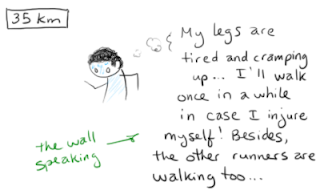There's a lot of weight on the other side of the bar! Won't the bar flip over if you take the weights off on this side? Do you have to go back and forth and gradually take the weights off? You don't know what to do, you're kinda scared to remove the weights, you're still panting, and you suddenly wish you'd read a blog talking about pivot points.
Center of Mass
A typical olympic bar weighs 20kg (45 lbs), and you put 80kg in weights, which totals to 100 kg. When the weights are on each side, the system's center of mass is at the middle.
What happens when the weights on one side are removed? The center of mass is shifted towards the weighted side. The bar will flip if the center of mass goes beyond the hook.
So, will 40kg of weight be enough to flip the bar?
The Barbell
First, let's define the barbell and weight plates. Everything is different everywhere, but I'm trying to stay as close to reality as possible. The barbell we're using is based on a normal olympic barbell. Assuming a constant volumetric mass (density), you can get the weight of the different components.
Let's also define our weight plate set.
Let's also assume that, with your current set-up, the hook (pivot point) is 0.100 meter (10 centimeters) from the larger part where you put the weights, so 0.545 meter from the end. Also, for the example, your 40 kg weight plates are: 3× 10 kg + 2× 5 kg.
40 Kilograms on One Side
How can you know if the bar is going to fall? The farther from the pivot point a weight is, the heavier its impact will be. For example, if you have a 5 kg weight 0.1 meter from the pivot, its impact will be less than the same weight a meter away. As a matter of fact, it will have ten times less impact (1 ÷ 0.1).
It's not so easy, though. We don't have pinpoint weights. They are spread out, so we need to use integrals. Let's first calculate how the barbell will act around the pivot point.
You can calculate how much the weight is spread out by dividing the weight by its length. For example, the 10 kg weight is spread over 0.026 meter, so it is 10kg / 0.026m = 385kg/m. This will be used during the integral calculations.
Now, the farther the weight is, the more impact it has on the system. This is linearly proportional to the distance.
By calculating the area under the curve (the integral), we can compare the two sides of the pivot. The heavier side will win and bring the bar down. Of course, if the left side is heavier, the bar will just rest on the left hook and stay there.
With some calculations (which will be seen shortly), we can learn that the left side is 13.28kg·m, or equivalent to a 13.28kg weight placed a meter away from the pivot, while the right side is equivalent to a 12.17kg weight a meter on the other side. For simplicity, this will be called the impact.
Left side is heavier, so that's enough to keep the bar on the hooks, but the choice of weights could definitely be better. The weights that are farther have a lot more impact - the two 5kg have a 4.76kg·m impact, compared to the three 10kg's 5.23kg·m impact. If we would have chosen four 10kg, they would have had a total impact of 7.49kg·m. Two 20kg would have a 6.8kg·m impact.
Mathematics
What is the impact of the barbell alone? We can split the bar into its constituents, depending on the position.
We can formulate the following integrals
and, knowing the density of the constituents and their position, calculate everything.
The rest is similar. If you have, for example, a stack of twenty 1.25kg, their impact will be 8.375kg·m (integral from 0.135m to 0.535m, with density 62.5kg/m).
When Will the Bar Fall?
Turns out that for normal weight ranges, it's pretty hard to make the bar fall.
If you take a single 25kg weight and place it at the very end, it will be enough to cause a crash. A single 20kg at the end will not, though.
Under a smart weight selection, three 20kg weights will be just enough to tilt the bar. If it happens, it means you were bench-pressing 120kg (264lbs), and at that weight, you should have a spotter.

















































